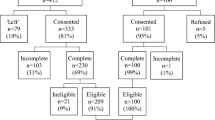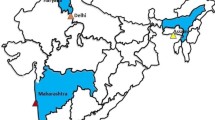Abstract
Purpose
Health-related quality of life (HRQoL) and associated factors were assessed among 155 Indigenous Australian adult cancer patients 6 months post-diagnosis.
Methods
The Assessment of Quality of Life-4D Questionnaire was used to assess HRQoL. Differences in the median utility score among subgroups of interest were examined using nonparametric tests. Factors associated with excellent HRQoL were assessed through logistic regression.
Results
Participants’ mean age was 52 years (range 20–78), and the majority were female (60 %), unemployed (72 %), and recruited from outpatients clinics (64 %). Breast cancer (27 %) was the most common diagnosis. The median HRQoL score was 0.62; 14 % of participants reported excellent HRQoL (>0.90). After adjusting for age, admission status, and treatment, excellent HRQoL was more likely among participants of Torres Strait Islander origin [adjusted odds ratio (AOR) 3.68; 95 % CI 1.23–11.01], those living in regional areas (AOR 5.59; 95 % CI 1.42–22.06), and those whose main language spoken at home was not English (AOR 3.60; 95 % CI 1.08–11.99) and less likely among those reporting less contact with Indigenous people (AOR 0.23; 95 % CI 0.68–0.81).
Conclusion
Assessing HRQoL is important to identifying and improving the length and quality of cancer survivorship, especially in groups that have significantly poorer cancer outcomes, such as Indigenous Australians. Acknowledging the study’s observational nature, we found HRQoL was lower than reported for other Australians, and we identified some socio-demographic factors that were associated with excellent HRQoL. Such assessments are an important component of identifying and evaluating appropriate interventions to improve the health and well-being of Indigenous cancer patients.
Similar content being viewed by others
References
Australian Institute of Health and Welfare. (2013). Cancer in aboriginal and Torres Strait Islander peoples of Australia: An overview. Canberra, Australia: AIHW.
Condon, J. R., Garvey, G., Whop, L. J., et al. (2013). Aboriginal and Torres Strait Islander Australians and cancer. Cancer Forum, 37(1), 27–30.
Cunningham, J., Rumbold, A. R., Zhang, X., & Condon, J. R. (2008). Incidence, aetiology, and outcomes of cancer in Indigenous peoples in Australia. The Lancet Oncology, 9(6), 585–595.
Butow, B., & Hagerty, R. (2006). The psycho-oncology co-operative research group. Cancer Forum, 30(1), 3.
Hammerlid, E., & Taft, C. (2001). Health-related quality of life in long-term head and neck cancer survivors: A comparison with general population norms. British Journal of Cancer, 84(2), 149–156.
Bottomley, A. (2002). The cancer patient and quality of life. The Oncologist, 7(2), 120–125.
Booth, C. M. (2010). Evaluating patient-centered outcomes in the randomized controlled trial and beyond: Informing the future with lessons from the past. Clinical Cancer Research, 16(24), 5963–5971.
Braun, D. P., Gupta, D., & Staren, E. D. (2011). Quality of life assessment as a predictor of survival in non-small cell lung cancer. BMC Cancer, 11, 353.
Anderson, K. L., & Burckhardt, C. S. (1999). Conceptualization and measurement of quality of life as an outcome variable for health care intervention and research. Journal of Advanced Nursing, 29(2), 298–306.
Richardson, J. R., Peacock, S. J., Hawthorne, G., Iezzi, A., Elsworth, G., & Day, N. A. (2012). Construction of the descriptive system for the assessment of quality of life AQoL-6D utility instrument. Health Qual Life Outcomes, 10, 38.
Hawthorne, G., Korn, S., & Richardson, J. (2013). Population norms for the AQoL derived from the 2007 Australian National Survey of Mental Health and Wellbeing. Australian and New Zealand Journal of Public Health, 37(1), 7–16.
Hawthorne, G., & Osborne, R. (2005). Population norms and meaningful differences for the Assessment of Quality of Life (AQoL) measure. Australian and New Zealand Journal of Public Health, 29(2), 136–142.
O’Neil, A., Stevenson, C. E., Williams, E. D., Mortimer, D., Oldenburg, B., & Sanderson, K. (2013). The health-related quality of life burden of co-morbid cardiovascular disease and major depressive disorder in Australia: Findings from a population-based, cross-sectional study. Quality of Life Research, 22(1), 37–44.
Manser, R. L., Wright, G., Byrnes, G., et al. (2006). Validity of the Assessment of Quality of Life (AQoL) utility instrument in patients with operable and inoperable lung cancer. Lung Cancer, 53(2), 217–229.
Revicki, D. A., Osoba, D., Fairclough, D., et al. (2000). Recommendations on health-related quality of life research to support labeling and promotional claims in the United States. Quality of Life Research, 9(8), 887–900.
Kimman, M., Jan, S., Monaghan, H., & Woodward, M. (2015). The relationship between economic characteristics and health-related quality of life in newly diagnosed cancer patients in Southeast Asia: Results from an observational study. Quality of Life Research, 24(4), 937–949.
Farkkila, N., Torvinen, S., Roine, R. P., et al. (2014). Health-related quality of life among breast, prostate, and colorectal cancer patients with end-stage disease. Quality of Life Research, 23(4), 1387–1394.
Jordan, K., Proskorovsky, I., Lewis, P., et al. (2014). Effect of general symptom level, specific adverse events, treatment patterns, and patient characteristics on health-related quality of life in patients with multiple myeloma: Results of a European, multicenter cohort study. Supportive Care in Cancer, 22(2), 417–426.
Jordhoy, M. S., Fayers, P., Loge, J. H., Saltnes, T., Ahlner-Elmqvist, M., & Kaasa, S. (2001). Quality of life in advanced cancer patients: The impact of sociodemographic and medical characteristics. British Journal of Cancer, 85(10), 1478–1485.
Hoyer, M., Johansson, B., Nordin, K., et al. (2011). Health-related quality of life among women with breast cancer: A population-based study. Acta Oncologica, 50(7), 1015–1026.
Parker, P. A., Baile, W. F., de Moor, C., & Cohen, L. (2003). Psychosocial and demographic predictors of quality of life in a large sample of cancer patients. Psychooncology, 12(2), 183–193.
Shen, F. R., Liu, M., Zhang, X., Feng, Y. H., Zhou, L. S., & Chen, Y. G. (2012). Health-related quality of life among breast cancer patients and its influencing factor in a Chinese population. Asian Pacific Journal of Cancer Prevention, 13(8), 3747–3750.
Micklem J. M. (2015). Self-reported health-related quality-of-life issues for Aboriginal and Torres Strait Islander patients with experience of cancer in Australia: A review of literature. International Journal of Evidence-Based Healthcare, 13(4), 233–253.
Charlson, M. E., Pompei, P., Ales, K. L., & MacKenzie, C. R. (1987). A new method of classifying prognostic comorbidity in longitudinal studies: development and validation. Journal of Chronic Diseases, 40(5), 373–383.
Australian Institute of Health and Welfare. (2004). Rural, regional and remote health: A guide to remoteness classifications. Canberra, Australia: AIHW.
Australian Bureau of Statistics. (2006). Census of population and housing: socio-economic indexes for areas (SEIFA) Australia, 2006. Vol ABS Cat. No. 2033.0.55.001. Canberra, Australia: ABS.
Engel, J., Kerr, J., Schlesinger-Raab, A., Eckel, R., Sauer, H., & Holzel, D. (2003). Quality of life in rectal cancer patients: A four-year prospective study. Annals of Surgery, 238(2), 203–213.
Burhansstipanov, L., Dignan, M., Jones, K. L., Krebs, L. U., Marchionda, P., & Kaur, J. S. (2012). Comparison of quality of life between native and non-native cancer survivors: Native and non-native cancer survivors’ QOL. Journal of Cancer Education, 27(1 Suppl), S106–S113.
Atlantis, E., Goldney, R. D., Eckert, K. A., & Taylor, A. W. (2012). Trends in health-related quality of life and health service use associated with body mass index and comorbid major depression in South Australia, 1998–2008. Quality of Life Research, 21(10), 1695–1704.
Teoh, V., Sims, J., & Milgrom, J. (2009). Psychosocial predictors of quality of life in a sample of community-dwelling stroke survivors: A longitudinal study. Topics in Stroke Rehabilitation, 16(2), 157–166.
Hawthorne, G., Richardson, J., & Osborne, R. (1999). The Assessment of Quality of Life (AQoL) instrument: A psychometric measure of health-related quality of life. Quality of Life Research, 8(3), 209–224.
Australian Institute of Health and Welfare. (2011). The health and welfare of Australia’s Aboriginal and Torres Strait Islander people: An overview 2011. Canberra.
Australia Co. (2013). National Aboriginal and Torres Strait Islander Health Plan 2013–2023. In Ageing DoHa, ed. Canberra, ACT.
King, M., Smith, A., & Gracey, M. (2009). Indigenous health part 2: The underlying causes of the health gap. Lancet, 374(9683), 76–85.
Anderson, I. P. (2004). Recent developments in national Aboriginal and Torres Strait Islander health strategy. Australia and New Zealand health policy, 1(1), 3.
Herrman, H., Hawthorne, G., & Thomas, R. (2002). Quality of life assessment in people living with psychosis. Social Psychiatry and Psychiatric Epidemiology, 37(11), 510–518.
Ackerman, I. N., Graves, S. E., Bennell, K. L., & Osborne, R. H. (2006). Evaluating quality of life in hip and knee replacement: Psychometric properties of the World Health Organization Quality of Life short version instrument. Arthritis and Rheumatism, 55(4), 583–590.
Acknowledgments
The authors thank the staff and Indigenous patients of the participating hospitals for their assistance and cooperation in carrying out this study and Dr. Christina Bernardes for assistance and project management.
Funding
This work was supported by the Australian National Health and Medical Research Council (NHMRC #1004643]. The views expressed in this publication are those of the authors and do not reflect the views of the NHMRC. The funders had no role in study design, data collection and analysis, decision to publish, or preparation of the manuscript. It was undertaken under the auspices of the Centre of Research Excellence in Discovering Indigenous Strategies to improve Cancer Outcomes Via Engagement, Research Translation and Training (DISCOVER-TT CRE, funded by the National Health and Medical Research Council #1041111), and the Strategic Research Partnership to improve cancer control for Indigenous Australians (STREP Ca-CIndA, funded through Cancer Council NSW (SRP 13-01) with supplementary funding from Cancer Council WA). JC was funded by an Australian National Health and Medical Research Council (NHMRC) Research Fellowship (#1058244), V Yf He was supported by University Postgraduate Research Scholarship by Charles Darwin University, PCV and MJ were funded by separate NHMRC Career Development Fellowships (#1083090 and #1045247, respectively), SKC’s contribution was supported by the Department of Health through the Rural Clinical Training and Support programme. The views expressed in this publication are those of the authors and do not necessarily reflect the views of the funding agencies.
Author information
Authors and Affiliations
Corresponding author
Ethics declarations
Conflict of interest
The authors declare that they have no relevant conflicts of interest.
Ethical approval
This study was approved by the Charles Darwin University, Northern Territory Department of Health and Menzies School of Health Research, QIMR Berghofer Medical Research Institute Human Ethics Committees, and the Human Ethics Committees of the four participating hospitals. The study was conducted according to the Helsinki ethical principles of research.
Informed consent
All participants provided informed consent prior to their participation in the research.
Rights and permissions
About this article
Cite this article
Garvey, G., Cunningham, J., He, V.Y. et al. Health-related quality of life among Indigenous Australians diagnosed with cancer. Qual Life Res 25, 1999–2008 (2016). https://doi.org/10.1007/s11136-016-1233-6
Accepted:
Published:
Issue Date:
DOI: https://doi.org/10.1007/s11136-016-1233-6




